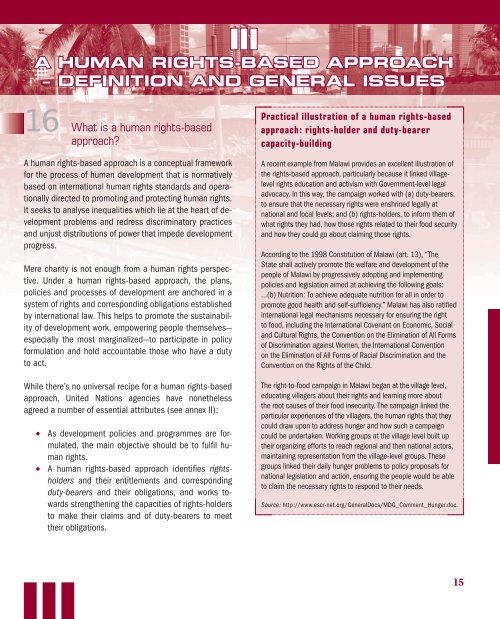Frequently Asked Questions on Human Rights-Based Approach
Frequently Asked Questions on Human Rights-Based Approach
Frequently Asked Questions on Human Rights-Based Approach
- No tags were found...
You also want an ePaper? Increase the reach of your titles
YUMPU automatically turns print PDFs into web optimized ePapers that Google loves.
IIIA HUMAN RIGHTS-BASED APPROACH– DEFINITION AND GENERAL ISSUES16 What is a human rights-basedapproach?A human rights-based approach is a c<strong>on</strong>ceptual frameworkfor the process of human development that is normativelybased <strong>on</strong> internati<strong>on</strong>al human rights standards and operati<strong>on</strong>allydirected to promoting and protecting human rights.It seeks to analyse inequalities which lie at the heart of developmentproblems and redress discriminatory practicesand unjust distributi<strong>on</strong>s of power that impede developmentprogress.Mere charity is not enough from a human rights perspective.Under a human rights-based approach, the plans,policies and processes of development are anchored in asystem of rights and corresp<strong>on</strong>ding obligati<strong>on</strong>s establishedby internati<strong>on</strong>al law. This helps to promote the sustainabilityof development work, empowering people themselves—especially the most marginalized—to participate in policyformulati<strong>on</strong> and hold accountable those who have a dutyto act.While there’s no universal recipe for a human rights-basedapproach, United Nati<strong>on</strong>s agencies have n<strong>on</strong>ethelessagreed a number of essential attributes (see annex II):As development policies and programmes are formulated,the main objective should be to fulfi l humanrights.A human rights-based approach identifi es rightsholdersand their entitlements and corresp<strong>on</strong>dingduty-bearers and their obligati<strong>on</strong>s, and works towardsstrengthening the capacities of rights-holdersto make their claims and of duty-bearers to meettheir obligati<strong>on</strong>s.Practical illustrati<strong>on</strong> of a human rights-basedapproach: rights-holder and duty-bearercapacity-buildingA recent example from Malawi provides an excellent illustrati<strong>on</strong> ofthe rights-based approach, particularly because it linked villagelevelrights educati<strong>on</strong> and activism with Government-level legaladvocacy. In this way, the campaign worked with (a) duty-bearers,to ensure that the necessary rights were enshrined legally atnati<strong>on</strong>al and local levels; and (b) rights-holders, to inform them ofwhat rights they had, how those rights related to their food securityand how they could go about claiming those rights.According to the 1998 C<strong>on</strong>stituti<strong>on</strong> of Malawi (art. 13), “TheState shall actively promote the welfare and development of thepeople of Malawi by progressively adopting and implementingpolicies and legislati<strong>on</strong> aimed at achieving the following goals:…(b) Nutriti<strong>on</strong>: To achieve adequate nutriti<strong>on</strong> for all in order topromote good health and self-suffi ciency.” Malawi has also ratifi edinternati<strong>on</strong>al legal mechanisms necessary for ensuring the rightto food, including the Internati<strong>on</strong>al Covenant <strong>on</strong> Ec<strong>on</strong>omic, Socialand Cultural <strong>Rights</strong>, the C<strong>on</strong>venti<strong>on</strong> <strong>on</strong> the Eliminati<strong>on</strong> of All Formsof Discriminati<strong>on</strong> against Women, the Internati<strong>on</strong>al C<strong>on</strong>venti<strong>on</strong><strong>on</strong> the Eliminati<strong>on</strong> of All Forms of Racial Discriminati<strong>on</strong> and theC<strong>on</strong>venti<strong>on</strong> <strong>on</strong> the <strong>Rights</strong> of the Child.The right-to-food campaign in Malawi began at the village level,educating villagers about their rights and learning more aboutthe root causes of their food insecurity. The campaign linked theparticular experiences of the villagers, the human rights that theycould draw up<strong>on</strong> to address hunger and how such a campaigncould be undertaken. Working groups at the village level built uptheir organizing efforts to reach regi<strong>on</strong>al and then nati<strong>on</strong>al actors,maintaining representati<strong>on</strong> from the village-level groups. Thesegroups linked their daily hunger problems to policy proposals fornati<strong>on</strong>al legislati<strong>on</strong> and acti<strong>on</strong>, ensuring the people would be ableto claim the necessary rights to resp<strong>on</strong>d to their needs.Source: http://www.escr-net.org/GeneralDocs/MDG_Comment_Hunger.doc.15
















